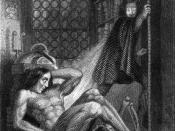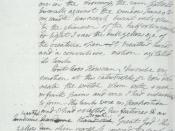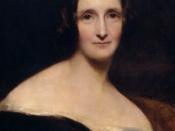How does mary shelley manipulate our feelings throughout the novel 'frankenstein'? And who is the real monster? Frankenstein'Frankenstein' is a popular gothic novel. It was written, by Mary Shelley, in 1816 and was published in 1818. The novel is about Victor Frankenstein, an experimental scientist who creates a monster, unaware that his creation will be the cause of numerous deaths. 'Frankenstein' was based on a waking dream Mary had, when she was 18, whilst in Geneva with her husband Percy Bysshe Shelley. Mary did not know her novel would still be studied almost two hundred years later, because of its moral messages and prodigal story line.
Throughout the novel our feelings for Victor and the monster vary dramatically. There are moments we sympathise with them, yet there are times we strongly dislike them. Sometimes we are unsure how to feel, this is called ambiguous morality. In chapter five the subjective narrator is Frankenstein.
Mary Shelley uses him in this part of the novel to manipulate our feelings. She makes us feel the same emotions as Frankenstein does by using this technique. The reader feels closer to Frankenstein at this point because they feel as if they're making a connection with him. Frankenstein spent a long period of time creating his monster, and when it was complete he wasn't entirely happy with the result. "The beauty of the dream vanished" this tells you that he was expecting the monster to be extraordinary, something so admirable you could only find it in 'dreams'. However, his ending result wasn't as good as he imagined it to be. The phrase gives us the impression he is disappointed with his own creation.
"Breathless horror and disgust filled my heart," suggests he is mortified with what he has made. So shocked it takes his...


